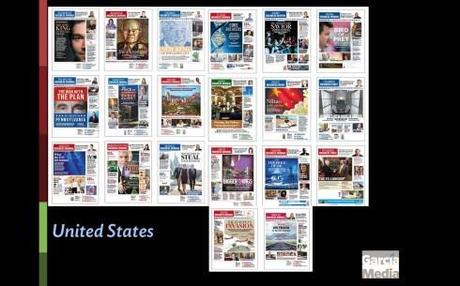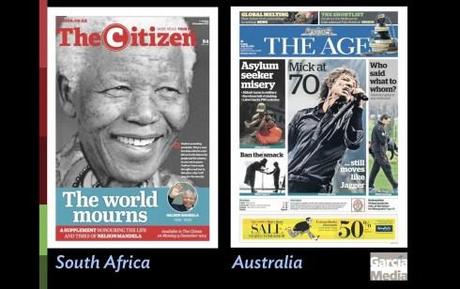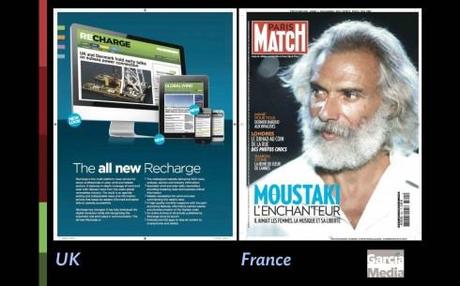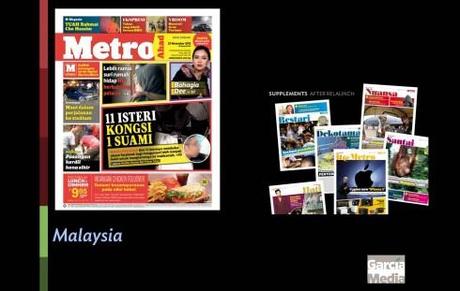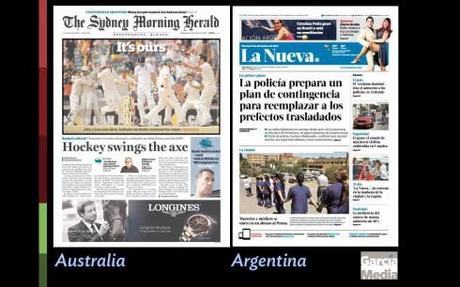TheMarioBlog will resume publication on January 6, 2014. It will, of course, be updated as needed. However, it is time to celebrate Christmas and to welcome the new year, and to take a break from our daily duties. Best wishes to all for the happiest of holidays and a 2014 full of health and success.
TAKEAWAY: Here are 7 reasons why 2014 should be a great year for the media. Raise that glass of bubblies and get ready to celebrate.
This is one time when I totally disagree with Tina Brown’s assessment of the state of the media, circa end of 2013. Ms. Brown, the outgoing DailyBeast and Newsweek editor, recently said at a conference that journalism is having a “very, very pathetic moment.”
Not so, in my view.
Perhaps I am the eternal optimist, but I find many reasons for us to lift that flute of Veuve Clicquot and toast all that is good and what we have to look forward to in 2014. Here are at least seven reasons to celebrate:
New newspapers are born (in print)
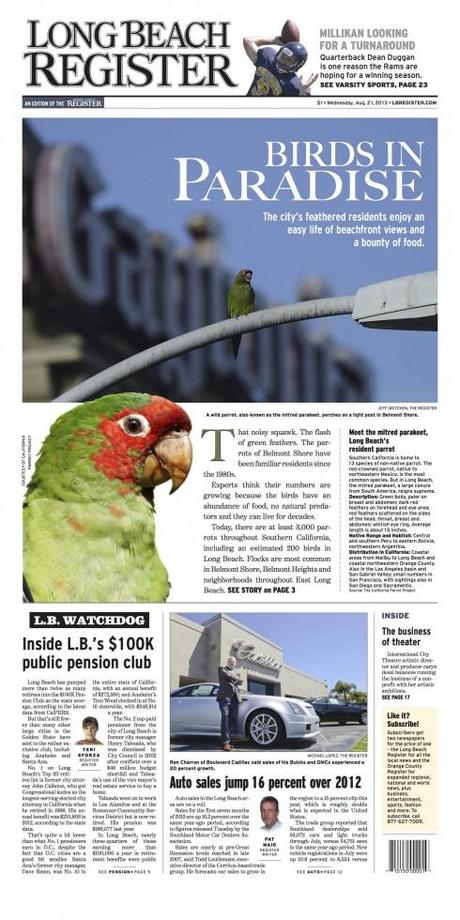
The Long Beach Register appeared August 19, 2013
What do the Long Beach Register and the Los Angeles Register have in common? In addition to the same publisher, as in The Orange County Register’s Aaron Kuschner, these two titles are first cousins, part of what is obviously an expansion plan for Kuschner as he applies his formula of very local news at the center of his newspapers.
Kushner, who believes in the value provided by a good local newspaper, has made news all through 2013 for doubling newsroom staff to 360 people, increasing the paper’s print output with 786 extra pages of content and new sections (including 12 special sections), re-opening its Washington bureau and establishing fresh wire services for foreign news reporting. But, the most important centerpiece of his influence: returning to local coverage that puts the faces of local boys and girls on the pages of his newspapers.
The result: Kushner has made an effort to revive print media by reinvesting in the newsroom, raising prices and implementing a strict pay wall for the Register’s website.
Now that the Long Beach Register premiered in August with a 10,000 press run, Kusher turns his attention to a new addition to the family, Los Angeles Register, which will compete head on with the Los Angeles Times in 2014
Mobile platforms is where the action is

Image from http://www.telco.com
The numbers are there to back up our thoughts: half of U.S. adults now own mobile devices and a majority use them for news. Over a third report getting news daily on the tablet and the smartphone, putting it on par with other activities such as email and playing games on tablets and behind only email on smartphones.
Not that we need to look at those numbers when all we have to do is take note of what is happening around us at train stations, airports, restaurants and even the beach: people with their eyes and fingers on a mobile device (and not necessarily the very young, either).
Publishers are waking to the reality that mobile is where the action and the money are going to be. Mobile first is the new catch phrase of the newsroom for 2014, giving digital first a much needed break.
The potential for mobile editions, and for storytelling that adapts to the needs of both phones and tablets, is enormous. Some of our own Garcia Media projects in 2014 are precisely in the creation of mobile platform editions.
The young: always connected and liking what we produce

Image from http://nycprowler.com
The young users are tuned in to news and consuming it somewhat voraciously. A recent Pew Research study offers us valuable information about them.
First, millenials use their tablets and smartphones to read the news at nearly identical rates to 30- and 40-somethings. And, the good news for advertisers: those 18-to 29-year-old tablet news users touch or click on ads when getting news to a far greater degree than older generations.
Ironically, the young mobile readers don’t want apps and mobile browsers that look like the future. They want apps that look like the past: 58% of those under 50, and 60% of Millennials, prefer a “print-like experience” over tech features like audio, video, and complex graphics
Multimedia storytelling taken root
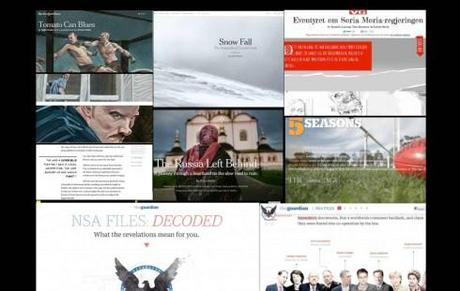
Perhaps it was the impact and influence of The New York Times’ Snow Fall“, or the fact that newsrooms are starting to feel more comfortable creating stories that adapt to the various platforms through which they publish, but, in any case, multimedia storytelling has gained momentum in 2013 and is likely to exploit in 2014.
We will see more editors and designers who approach each project looking at the story first, and then deciding on the medium.
While multimedia storytelling is still in its infancy, I am happy to say that I see a greater awareness for the dynamics of how to plan and to execute multimedia stories. Editors and writers are well aware that the story comes first, then the decision for how it will play on different platforms, or on which platforms.
Be prepared to see great examples of multimedia storytelling from around the world in the year ahead.
Data-powered storytelling is upfront
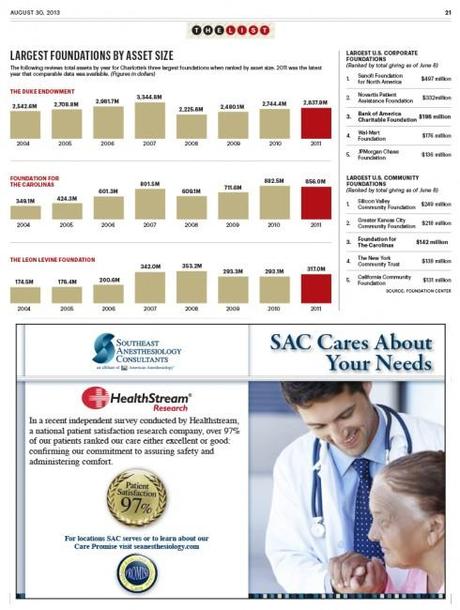
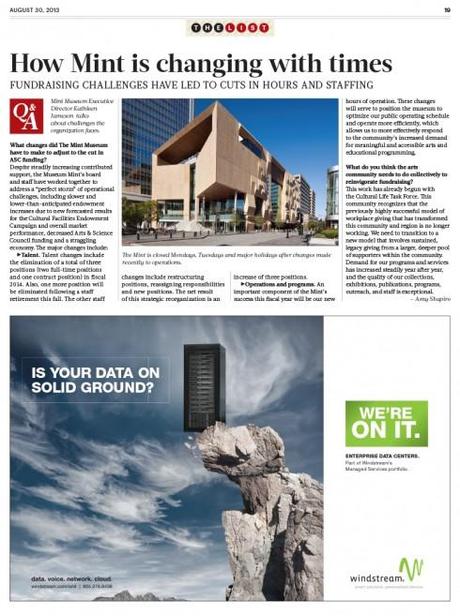
The List and data visualization from the Charlotte Business Journal
In the 80s, infographics revolutionized the way we tell stories visually. Editors and designers learned that it is not just words and photos that tell stories. Numbers, charts, graphs and illustrations with information do too, and how.
Today, with digital platforms making data easier to present—-as well as more fun to consume—-we are seeing a renaissance of graphics for presentation of data. We saw much progress in this area in 2013.
“There were several themes throughout the year, but the most important was the strengthened connection between data and reality,“ as reported in Flowing Data.
It is true that lists and data presented visually rank at the top of the preference list, especially for younger readers. In our work, we have witnessed first hand the popularity of Lists and other Data-Driven presentations, as with the 40 Business Journals that are part of American City Business Journal.
We will see more of this in 2014, I predict.
For more on data visualization:
Reinventing newspapers

One of the highlights of 2013 was the announcement that Jeff Bezos, of Amazon fame, had bought The Washington Post. There are high expectations for Bezos and what he will do with this iconic American newspaper, but, to me, what is more interesting is that someone of his generation and background would show interest in buying a print newspaper.
Of course, Bezos got a bargain in the process having bought the paper — once worth billions — for a mere $250 million.
As someone who worked with The Washington Post as it revamped its Sunday edition in 2011, I am curious—-and excited—-to see what changes come to the Post in 2014.
Not that I have a crystal ball in front of me, but, come to think about it, the natural progression in the Bezosization of the Post would be:
—Change its format to a tabloid, as the Sunday Style section already is.
—Devote the print product to a more analytical type of newspaper, perhaps more elite, and preparing it for a robust print weekend edition when the daily does not print anymore.
—Go full mobile/digital: mobile editions crafted for specific audiences at certain times of the day; more curated tablet edition with the best of the Post (but not necessarily news driven).
—Incorporate a branded content unit (Bezps’ Amazon can provide much material,and, in fact, it could be the engine driving it) in a way we have not yet seen in an American newspaper. Let the Post do to branded content in 2014 what its investigative teams did for journalism in the Watergate era.
If there is anyone who can do it, it is Bezos.
I suspect, too, that just like Aaron Kushner and Jeff Bezos, other digitally minded “saviors” will appear to snatch the top print brands, and reinvent them.
Long time overdue, but, in 2014, likely to happen. We wait to see all of this very eagerly.
Branded content—-advertising
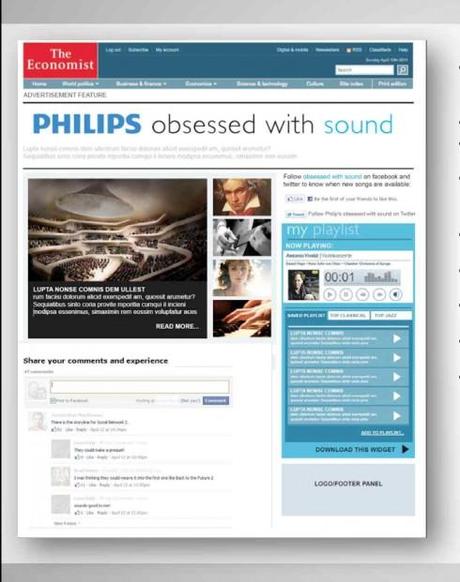
From The Economist
What could be better than the marriage of storytelling, good brands—-and revenue?
In 2013, we have seen more and better examples of the union of advertising and editorial content. With a more robust union has come a new name to describe the combination, as in branded content, or, even better, branded journalism.
We have seen it play well in such well known and respected titles as The Economist and The New York Times . But, we have also seen it take off with Quartz, which abandoned those ineffective banners and substituted them with real content that sells brands and what they do, in storytelling formats, as opposed to a direct in your face sale of a product.
Brands need well respected publications to carry their messages, but NOT as traditional advertising. Publishers need revenue.
And, the good news: storytellers and designers are going to be needed to take branded content to its final destination—the pages and screens of a publication.
In his book published this year, Ebele Wybenga, the 26-year-old author of The Editorial Age, said it best:
Many journalists are afraid that succumbing to commercial interests will irreparably damage the role of the press as public watchdog…..I argue that journalists can benefit from collaborations with brands and that brands can benefit from a journalistic approach, while serving, rather than misleading today’s audience.
Of related interest: Nieman Lab predictions for 2014
Predictions for Journalism 2014: A Nieman Lab Series
The Demographics of Mobile News: Men, College Grads and the Young are More Engaged
http://www.journalism.org/2012/12/11/demographics-mobile-news/
Garcia Media projects 2013
It was a busy, productive and exciting year for the Garcia Media team across the globe. Here is a sampling of those projects that launched in the past 12 months through Garcia Media, Garcia Media Europe and Garcia Media Latinoamerica.
We now prepare to take a well deserved break during Christmas and New Year, then start the new year with a series of projects all of which deal with media quartet enhancements for publications in 6 countries.
